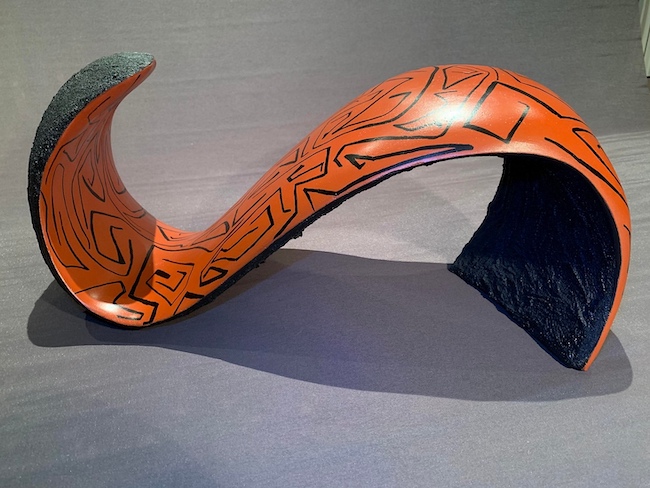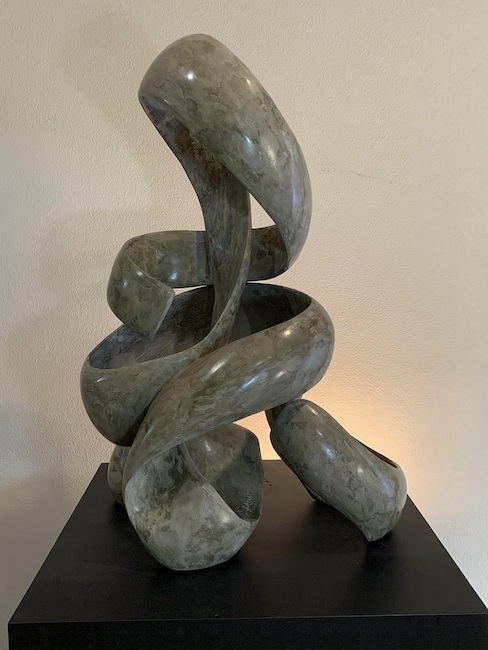Nel campo dell’espressione emotiva gli artisti contemporanei hanno appreso la libertà stilistica che ha concesso loro di attingere ai grandi maestri del passato superando però il loro stile attraverso un riadattamento, un processo di evoluzione delle linee guida precedenti per raggiungere un linguaggio personalizzato, più affine alla realtà attuale e molto più in armonia con un modo moderno di affrontare temi, simboli e allegorie dell’esistenza. L’artista di cui vi racconterò oggi mostra un’impronta decisamente personale nel mondo scultoreo grazie alla quale riesce ad avvolgere l’osservatore di misteriosi significati tutti da decifrare.
In tutto il panorama artistico contemporaneo si assiste costantemente a ispirazioni provenienti dal passato più lontano che vanno a mescolarsi con le innovazioni delle avanguardie del Ventesimo secolo per essere oltrepassate e sperimentate anche in virtù dei nuovi materiali che nelle tecniche tradizionali non venivano presi in considerazione, questo tanto nella pittura quanto nella scultura. Laddove infatti grandi artisti come Michelangelo, Caravaggio e Bernini riuscirono a infondere nelle loro opere immortali quel senso di fluidità nelle figure e del movimento inciso nel marmo, di contro nel Novecento, malgrado fosse stato messo in discussione ogni legame con l’immagine esteriore e l’aderenza alla realtà osservata, quella tendenza alla morbidezza espressiva, alla sinuosità di forme anche quando erano private di una riconducibilità a ciò che l’occhio conosceva, permase e costituì il carattere distintivo di molti scultori che lasciarono un profondo segno nel secolo scorso. Il grande rappresentante del Dadaismo prima e dell’Espressionismo Astratto poi, Jean Harp, sperimentò l’aspetto curvilineo nell’astrazione, utilizzando e forgiando materiali malleabili ma al tempo stesso inaspettati per essere utilizzati sotto forma artistica come la pietra calcarea, l’ottone lucidato, il gesso che erano necessari per enfatizzare e sottolineare il legame dell’uomo, sempre stilizzato, con la natura, ambiente fondamentale per perdersi e poi ritrovarsi, troppo spesso dimenticato a causa delle urgenze contingenti dell’esistenza, in un’epoca di conflitti in cui sopravvivere era la priorità. Altro grande esponente di quel dinamico periodo di sperimentazione fu Umberto Boccioni che, nella scultura come nella pittura, analizzò e si impegnò a riprodurre il senso di movimento, la dinamicità da cui era contraddistinto l’inizio del secolo scorso e che era linea guida della corrente a cui apparteneva, il Futurismo. Qualche anno dopo un altro gigante della scultura, Henry Moore, riprese le forme tondeggianti di Jean Harp estremizzandole e astraendole per esprimere solo un concetto legato al sentire e al pensiero che desiderava narrare, così come proseguì un percorso di ricerca del legame con la natura, e soprattutto con la naturalezza, che lo indussero a spingersi verso un contatto istintivo, primordiale con l’osservatore attraverso grandi opere necessitanti spazio per essere esposte e ammirate. In lui il movimento sperimentato da Boccioni divenne più lento, più adeguato ai ritmi di un nuovo sentire, più meditato e meno concitato o urgente rispetto al procedere dei primi decenni del Novecento. L’artista greco Aris Petridis, proveniente da un percorso di studi sportivi, sente la necessità di dare ascolto alla sua inclinazione artistica, a quell’irresistibile voce che lo conduce a scegliere proprio la scultura come forma espressiva più affine alla sua natura; e lo fa sperimentando un percorso che da un lato si ispira alle forme sinuose di Jean Harp e di Henry Moore, dall’altro tende verso il movimento morbido che affonda le sue radici nelle sculture classiche ma mobili di Michelangelo e di Caravaggio, abbandonando dunque quello concitato e scomposto di Boccioni perché Petridis va verso un ritmo più rilassato, più orientato alla riflessione e all’esplorazione della realtà che desidera raccontare.
La sua aderenza all’Astrattismo gli concede di osare l’utilizzo di materiali fuori dal comune, soprattutto nella loro inusuale associazione; ciò su cui ama misurarsi infatti è la modellazione del cemento, un materiale sorprendentemente versatile e declinabile in molteplici sfumature ben differenti dall’uso abituale per cui è impiegato.
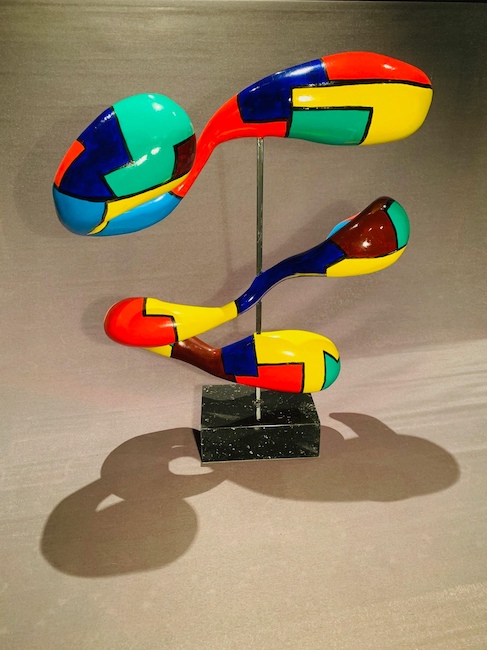
Petridis mostra una singolare abilità nel forgiare il cemento, nel trasformarlo per renderlo sottile e leggero come un nastro che plasma e arrotola per infondere una leggerezza esteriore funzionale ad approfondire il senso profondo delle immagini che desidera narrare, stilizzando e fornendo una sua personale interpretazione di iconografie tradizionali, di luoghi vissuti o solo immaginati, di sentimenti legati al comune sentire; la sua è una sperimentazione che va verso il concetto accompagnato a un’esteriorità indefinita eppure in grado di catturare l’emozione in virtù della sua inaspettata apparente morbidezza.
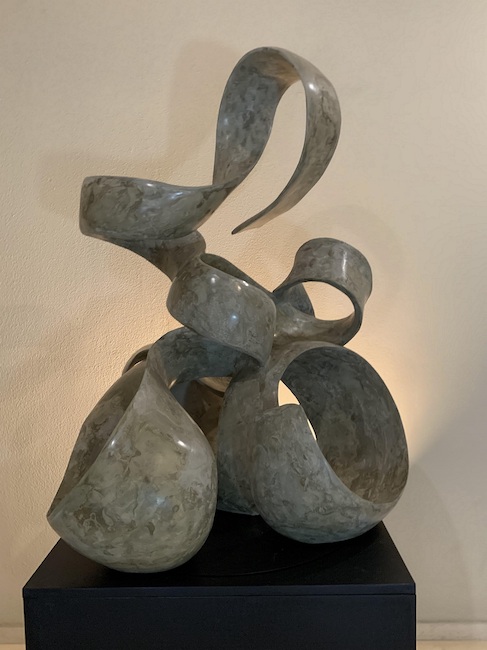
L’opera La Pietà racconta attraverso un linguaggio criptico ma fortemente emozionale, l’intensità di quel momento di abbandono e al tempo stesso di sostegno emotivo rappresentata magistralmente da Michelangelo Buonarroti e che in Aris Petridis viene essenzializzata dal suo tocco stilistico minimalista eppure in grado di infondere il medesimo pathos proprio in virtù delle curve ottenute attraverso il ripiegarsi su se stesso del cemento lucidato. L’effetto finale è di una luminosità che conquista lo sguardo, che accarezza l’interiorità attraverso l’emanazione della luce permettendo all’intensità espressiva di fuoriuscire malgrado l’ermeticità della forma.
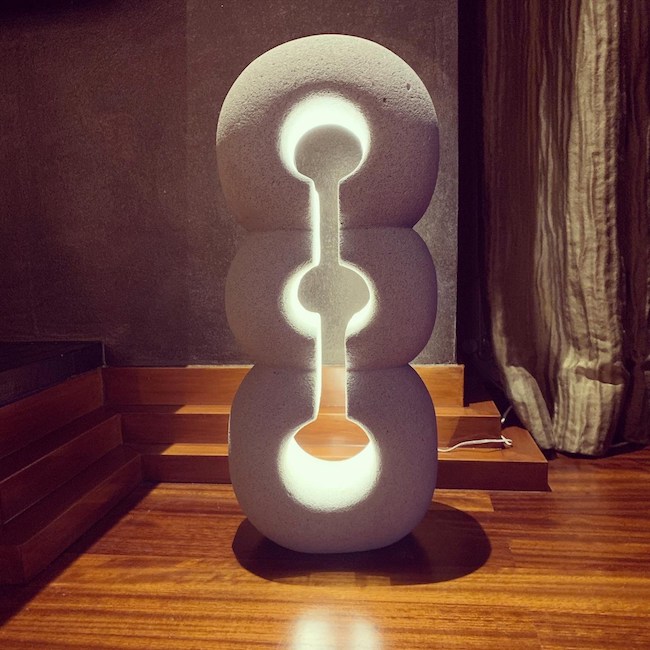
Nella scultura The light invece Petridis si sposta su un approccio più razionale, più volto alla ricerca dell’equilibrio tra risultato plastico e interazione con l’ambiente circostante che diviene a sua volta parte integrante dell’opera nella quale il cemento non è assottigliato né levigato bensì occupa in modo prepotente lo spazio intorno a sé; la sua superficie ruvida contribuisce ad ampliare l’effetto luminoso della scultura-lampada regalandole un senso di mistero, di enigma quasi metafisico dato dal forte impatto emozionale ma anche dalla sensazione di trovarsi davanti a un oggetto familiare pur non riuscendo a riconoscerne la sua abituale sembianza. Inganna lo sguardo l’artista, e coinvolge l’osservatore in un’esperienza dei sensi nella quale immergersi, ammirato.
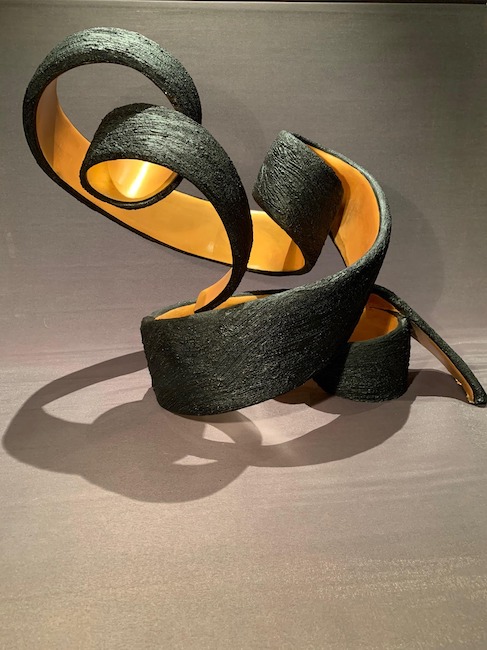
Ma un’altra caratteristica di Petridis è quella di mescolare due materie apparentemente inconciliabili come il cemento e la ceramica, per dar vita a creazioni sorprendenti per le quali prende ispirazione da luoghi o dettagli che lo hanno colpito, che hanno catturato il suo lato emozionale al punto di volerle immortalare nelle sue opere; Viper appartiene a quella serie di sculture in cui il colore e la versatilità della ceramica non solo decora bensì completa la base strutturale ondulata del cemento, raccontando con armonia plastica le volute e la sinuosità del piccolo rettile, esaltate e illuminate dalla superficie liscia e arancione del suo interno e lasciando all’esterno in cemento la ruvidezza a cui è affidato l’attrito con il terreno.
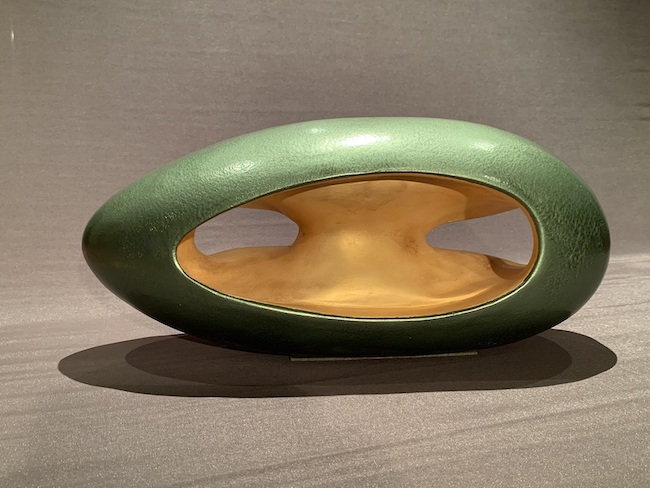
In Ibiza invece Petridis racconta tutta la solarità dell’isola spagnola, con quel verde acqua che rappresenta il mare limpido e i due fori nel cemento che sembrano voler osservare il ricordo di quanto vissuto nel frangente in cui si è trovato immerso in quel panorama; la levigatezza della superficie in ceramica contribuisce a infondere nell’osservatore quel senso di liquidità, di armonia tra sabbia e mare in cui lo sguardo dell’artista si è perso osservandola.
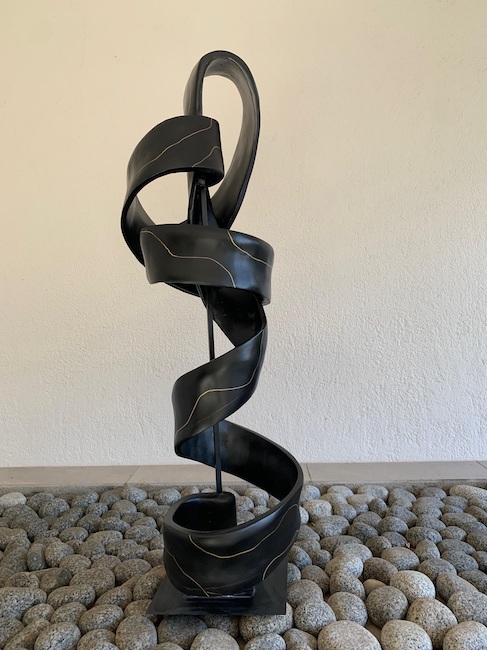
In Fifth Avenue, allo stesso modo, Aris Petridis racconta la dinamicità della via newyorkese, la sua essenza elegante e modaiola ma al tempo stesso quasi musicale, la struttura dell’opera infatti è particolarmente sinuosa, come se rappresentasse non solo i grattacieli che si ergono ai lati dell’esclusiva strada bensì anche i suoni che la contraddistinguono, quel misto tra atmosfera metropolitana e ordinario rumore che, a lungo andare, non viene quasi più percepito da chi è abituato a viverla. L’alta struttura in ceramica nera conferma ancora una volta il talento di Aris Petridis nel modellare e infondere eleganza mista a morbidezza alle sue opere in grado di conquistare sia gli appassionati di arte che gli arredatori di interni. Formatosi come autodidatta Aris Petridis partecipa regolarmente a mostre collettive in Grecia ricevendo l’approvazione di pubblico e di critica che incoraggiano un percorso artistico decisamente in ascesa.
ARIS PETRIDIS-CONTATTI
Email: arispetr@hotmail.com
Facebook: https://www.facebook.com/aris.petridis.773
Instagram: https://www.instagram.com/arispetr/
The softly curved appearance of the solid sculptures of Aris Petridis
In the field of emotional expression, contemporary artists have learnt the stylistic freedom that has allowed them to draw on the great masters of the past, but surpassing their style through a readaptation, a process of evolution of the previous guidelines to achieve a personalised language, more akin to current reality and much more in harmony with a modern way of dealing with themes, symbols and allegories of existence. The artist I am going to tell you about today shows a decidedly personal imprint in the world of sculpture, thanks to which he succeeds in enveloping the observer in mysterious meanings that have yet to be deciphered.
Throughout the contemporary art scene, we are constantly witnessing inspirations from the distant past that are mixed with the innovations of the twentieth-century avant-garde, which are then surpassed and experimented, also by virtue of new materials that were not taken into account in traditional techniques, both in painting and sculpture. Where in fact great artists such as Michelangelo, Caravaggio and Bernini succeeded in infusing their immortal sculptures with that sense of fluidity in the figures and movement engraved in the marble, on the other hand in the twentieth century, despite the fact that every link with the external image and adherence to observed reality had been questioned, that tendency towards expressive softness, to the sinuosity of forms even when they were deprived of a traceability to what the eye knew, persisted and constituted the distinctive character of many sculptors who left a profound mark on the last century.
The great representative of first Dadaism and then Abstract Expressionism, Jean Harp, experimented with the curvilinear aspect of abstraction, using and forging malleable yet unexpected materials to be used in artistic form such as limestone, polished brass, and plaster, which were necessary to emphasise and underline man’s link, always stylised, with nature, a fundamental environment in which to lose oneself and then find oneself, too often forgotten due to the contingent urgencies of existence, in an era of conflict in which survival was the priority. Another great exponent of this dynamic period of experimentation was Umberto Boccioni who, in sculpture as in painting, analysed and endeavoured to reproduce the sense of movement, the dynamism that characterised the beginning of the last century and was the guiding principle of the current to which he belonged, Futurism. A few years later, another giant of sculpture, Henry Moore, took up Jean Harp’s rounded forms, taking them to extremes and abstracting them to express only a concept linked to the feeling and thought he wished to narrate, just as he continued the search for a link with nature, and above all with naturalness, which led him to push towards an instinctive, primordial contact with the observer through large works that needed space to be exhibited and admired. In him, the movement experienced by Boccioni became slower, more appropriate to the rhythms of a new feeling, more meditated and less excited or urgent than the progress of the first decades of the 20th century. The Greek artist Aris Petridis, coming from a background of athletic studies, felt the need to listen to his artistic inclination, to that irresistible voice which led him to choose sculpture as the form of expression most akin to his nature; and he did so by experimenting with a path which, on the one hand, was inspired by the sinuous forms of Jean Harp and Henry Moore, and on the other, tended towards the soft movement rooted in the classical but mobile sculptures of Michelangelo and Caravaggio, thus abandoning Boccioni’s agitated and disorganised movement, as Petridis moved towards a more relaxed rhythm, more oriented towards reflection and exploration of the reality he wished to portray. His adherence to Abstractionism allows him to dare to use unusual materials, especially in their unusual association; what he loves to measure himself with is in fact the modelling of cement, a surprisingly versatile material that can be declined in multiple nuances very different from the usual use for which it is employed.
Petridis demonstrates a singular ability to forge cement, transforming it to make it thin and light like a ribbon that he shapes and rolls up to instil an external lightness that serves to deepen the profound sense of the images he wishes to narrate, stylising and providing his own personal interpretation of traditional iconographies, of places experienced or merely imagined, of feelings linked to common sense; his is an experimentation that goes towards the concept accompanied by an indefinite exteriority yet capable of capturing emotion by virtue of its unexpected apparent softness. The artwork La Pietà (The Piety) uses a cryptic but highly emotional language to describe the intensity of that moment of abandonment and at the same time of emotional support masterfully represented by Michelangelo Buonarroti, and which in Aris Petridis is essentialised by his minimalist stylistic touch yet capable of instilling the same pathos precisely by virtue of the curves obtained by folding polished concrete back on itself. The final effect is one of luminosity that captivates the eye, caressing the interior through the emanation of light and allowing expressive intensity to emerge despite the hermetic nature of the form. In the sculpture The light, Petridis shifts to a more rational approach, more aimed at finding a balance between the plastic result and the interaction with the surrounding environment, which in turn becomes an integral part of the artwork, in which the concrete is neither thinned nor polished, but rather overbearingly occupies the space around it; its rough surface helps to amplify the luminous effect of the lamp-sculpture, giving it a sense of mystery, of an almost metaphysical enigma given by its strong emotional impact, but also by the sensation of being in front of a familiar object even though one cannot recognise its usual appearance. The artist tricks the eye, and involves the observer in an experience of the senses in which to immerse himself, in admiration. But another characteristic of Petridis is that he mixes two apparently irreconcilable materials such as concrete and ceramic to give life to surprising creations for which he takes inspiration from places or details that have struck him, that have captured his emotional side to the point of wanting to immortalise them in his artworks; Viper belongs to that series of sculptures in which the colour and versatility of ceramics not only decorates but complements the undulating structural base of the cement, recounting with plastic harmony the volutes and sinuosity of the small reptile, enhanced and illuminated by the smooth orange surface of its interior and leaving on the cement exterior the roughness to which friction with the ground is entrusted.
In Ibiza, on the other hand, Petridis recounts all the sunshine of the Spanish island, with the water green representing the clear sea and the two holes in the concrete that seem to want to observe the memory of what he experienced when he found himself immersed in that landscape; the smoothness of the ceramic surface helps to instil in the observer that sense of liquidity, of harmony between sand and sea in which the artist’s gaze was lost when he observed it. Similarly, in Fifth Avenue, Aris Petridis recounts the dynamism of the New York street, its elegant and fashionable essence, but at the same time almost musical. The structure of the sculpture is particularly sinuous, as if it represented not only the skyscrapers that rise on either side of the exclusive street but also the sounds that distinguish it, that mixture of metropolitan atmosphere and ordinary noise that, in the long run, is almost no longer perceived by those who are used to living there. The tall black ceramic structure confirms once again the talent of Aris Petridis in modelling and infusing elegance mixed with softness into his artworks, which will win over art lovers and interior designers alike. Trained as a self-taught artist, Aris Petridis regularly participates in group exhibitions in Greece, receiving public and critical acclaim which encourages his artistic development.


